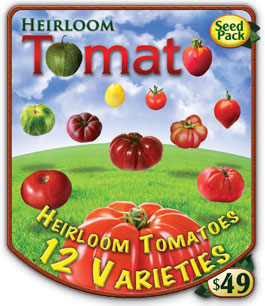|
Home > Guides > Packs > Tomato |
|
How to Grow Heirloom Tomato | Guide to Growing Heirloom Tomatoes |
Tips  Starting Starting  Transplanting Transplanting |
Although tomatoes are native to tropical regions of South America, in the last several centuries their popularity has continued to blossom. Today they are grown and cultivated in many regions across the globe, with hundreds of unique cultivars. As a testament to their preeminence, gardeners, horticulturalists and other growers will go great lengths to obtain the tomato with just the right qualities or growing characteristics to suit their desires. Heirloom tomatoes represent the most prized group of tomato cultivars. Many of these varieties are distinguished by their extraordinary taste or texture which, over the decades, has endeared it to tomato aficianados. These open-pollinated varieties have often been cultivated independently to prevent cross-pollination, the seeds carefully collected & passed from season to season, down from generation to generation.
|
 |
|
|
| |
|
|
| |
|
|
| |
Guide to Growing Heirloom Tomatoes |
| Guide to Growing Amish Paste |
|
Guide to Growing Black Krim |
|
Guide to Growing Brandywine |
 |
Amish Paste tomatoes are know for their juicy, thick texture and succulent taste. |
|
 |
Native to Russia, Black Krim are renowned for their great, mildy-tart taste. |
|
 |
Brandywine are among the oldest heirloom tomatoes, & have been grown for well
over 100 years. |
| |
| Guide to Growing Cherokee Purple |
|
Guide to Growing Green Zebra |
|
Guide to Growing Mortgage Lifter |
 |
The flavor is generally considered excellent and this variety often makes top ten lists for its taste. |
|
 |
Green Zebra tomato plants produce relatively small (1/2 pound) green and yellow striped tomatoes. |
|
 |
Mortgage Lifter tomatoes
are known for their sweet, rich flavor and prodigious size. |
| |
| Guide to Growing Pondorosa |
|
Guide to Growing Red Currant |
|
Guide to Growing Red Strawberry |
 |
Ponderosa tomatoes are flavorful and meaty-and are
a great tomato with low acidity. |
|
 |
Red Currant plants produce deep red tomatoes that are exceptionally sweet and packed with flavor. |
|
 |
Strawberry tomatoes are well-suited as slicers, and make an ideal addition to sandwiches and salads. |
| |
| Guide to Growing Siberian |
|
Guide to Growing Tomatillo |
|
Guide to Growing Yellow Plum |
 |
The small, round tomatoes are versatile, and are especially well-suited for sauces, juices, and pastes. |
|
 |
Tomatillos have a slightly tangy or citrus taste and are a key ingredient in many traditional Mexican dishes. |
|
 |
Yellow Plum tomatoes are flavorful and make a great slicer. |
| |
|
| |
|
|
|
| |
|
|
Tips on Growing Tomatoes:
Tomatoes can be demanding relative to many other garden vegetables. They generally require more light, water and nutrients than other crops. In addition, they often require the support of a cage or similar structure.
Starting Tomato Seeds
Most tomato varieties require a long growing season; at least 65 days or more. Starting your seeds indoors or in greenhouse, on a heat mat, is recommended. For best results, start your seeds approximately 6 weeks prior to transplanting, after the final frost of the spring. Keep the sowing medium warm (70-90 degrees F), and use a peat-based soilless medium to discourage soil-borne diseases that can trouble tomatoes plants.
Transplanting your Starts
After the frost has passed, you will want to begin hardening off your tomato starts by gradually exposing them to increasing amounts of sunlight and outdoor conditions. This will promote stronger, more prepared plants during the remainder of the growing cycle.
Select a location that receives plenty of sunlight, preferably facing south to take advantage of the long hours of the afternoon. Additionally, tomatoes are heavy feeders that will show better, faster growth in a site with soil rich in compost and other nutrient-rich constituents. Fertilize your tomatoes throughout the season, preferably with an organic blend that is lower in nitrogen that can promote leaf health but will compromise fruit quality.
After hardening, transplant on an overcast day once soil temps do not drop lower than 55 degrees. For best results, plant can be placed into the ground so that only 4-6 inches extend above the surface of the soil. This will promote stronger root systems, quicker harvests, and sturdier plants. Over the growing season, make sure that your plants receive plenty of light and moisture. Happy growing!

|
|